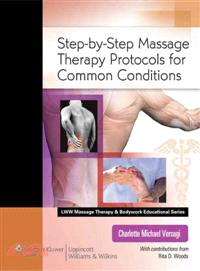Step-by-Step Massage Therapy Protocols for Common Conditions
商品資訊
系列名:Massage Therapy and Bodywork Educational
ISBN13:9780781787154
出版社:Lippincott Williams & Wilkins
作者:Charlotte Michael Versagi
出版日:2011/08/08
裝訂/頁數:平裝/342頁
規格:27.9cm*21.6cm*1.9cm (高/寬/厚)
定價
:NT$ 2440 元優惠價
:90 折 2196 元
無庫存,下單後進貨(到貨天數約30-45天)
下單可得紅利積點:65 點
商品簡介
目次
相關商品
商品簡介
Discover how to use your knowledge of massage to support clients with specific medical conditions!
Step-by-Step Massage Therapy Protocols for Common Conditions is intended to give massage therapy students and practitioners the knowledge and confidence to work safely with clients who have medical conditions. Relying on her many years of massage experience, Charlotte Michael Versagi outlines the skills needed to assess wisely, think critically, and use techniques already learned and practiced in massage school to work with these clients. The text provides practical, thorough protocols to help therapists support their clients while steering them away from doing any harm.
This text prepares the student in a massage program, or the therapist already practicing, to become an effective member of a client’s healthcare team. The book is designed so that the therapist can quickly understand the basics of the condition, the most common strategies for medical treatment, and how to relieve pain and help the client deal with the condition.
The book’s easy-to-navigate organization helps create an effective learning experience, presenting the foundation for protocols in chapters 1-5, and then turning to specific conditions (arranged alphabetically) in chapters 6-44.
Each condition chapter presents a comprehensive yet concise explanation of the condition—what causes it, how it develops, how it is treated, and how the massage therapist can assess the condition's effect on the client. The central feature of each of these chapters is the Massage Therapy Protocol, which presents in tabular form a suggested protocol for supporting healing with massage therapy.
Step-by-Step Massage Therapy Protocols for Common Conditions is intended to give massage therapy students and practitioners the knowledge and confidence to work safely with clients who have medical conditions. Relying on her many years of massage experience, Charlotte Michael Versagi outlines the skills needed to assess wisely, think critically, and use techniques already learned and practiced in massage school to work with these clients. The text provides practical, thorough protocols to help therapists support their clients while steering them away from doing any harm.
This text prepares the student in a massage program, or the therapist already practicing, to become an effective member of a client’s healthcare team. The book is designed so that the therapist can quickly understand the basics of the condition, the most common strategies for medical treatment, and how to relieve pain and help the client deal with the condition.
The book’s easy-to-navigate organization helps create an effective learning experience, presenting the foundation for protocols in chapters 1-5, and then turning to specific conditions (arranged alphabetically) in chapters 6-44.
Each condition chapter presents a comprehensive yet concise explanation of the condition—what causes it, how it develops, how it is treated, and how the massage therapist can assess the condition's effect on the client. The central feature of each of these chapters is the Massage Therapy Protocol, which presents in tabular form a suggested protocol for supporting healing with massage therapy.
Special Features Help You Successfully Implement the Massage Protocols—
- Pathophysiology helps readers understand the nature and progression of the medical condition.
- Thinking It Through offers a set of questions for the massage therapist to consider before working with the client.
- Massage Therapy Assessment guides therapists in evaluating a client’s condition for the purpose of designing and implementing an effective massage therapy program.
- Therapeutic Goals help readers determine what is—and is not—a goal of massage therapy when working with a client who has a medical condition.
- Contraindications and Cautions alert readers when particular massage techniques may be harmful or medical intervention may be necessary.
- Review Questions assess understanding of the medical condition and its treatment.
Bonus Online Resources!
The companion website located on thePoint offers a fully searchable online version of the book as well as a sample client homework sheet, sample SOAP notes, and Dermatome map.
Consistent Template
For each condition addressed in Chapters 6-44, the following template provides a comprehensive, concise picture of the medical condition and what the massage practitioner needs to know in order to support healing:
- Also known as (Different names for the condition)
- Definition (Brief description)
- General Information (Background)
—Morbidity and Mortality (Causes, who is affected, how serious it is) - Pathophysiology (How the disease works)
- Overall Signs and Symptoms
- Signs and Symptoms Massage Therapy Can Address
- Treatment Options
—Common Medications - Massage Therapist Assessment
- Therapeutic Goals
- Massage Session Frequency
- Massage Protocol
—Getting Started
—Step-by-Step Protocol - Homework (for the client)
- Review Questions
- Bibliography
Additional Features:
- Massage Therapy Tip
- Thinking It Through
- Contraindications and Cautions
目次
Part I Groundwork: Fundamental Knowledge for Intelligent Hands
Chapter 1 Defining and Practicing Clinical Massage
Chapter 2 Physiologic Effects of Basic Massage Strokes and Techniques
Chapter 3 The Physiology of Muscular Activity and Pain
Chapter 4 Medications for Common Medical Conditions
Chapter 5 Beyond the Table: Client Homework and Referring Out
Part II Step-by-Step Massage Therapy Protocols
Chapter 6 Ankylosing Spondylitis
Chapter 7 Bell's Palsy
Chapter 8 Bursitis
Chapter 9 Carpal Tunnel Syndrome
Chapter 10 Cerebral Palsy
Chapter 11 Chronic Fatigue Syndrome
Chapter 12 Constipation
Chapter 13 Degenerative Disc Disease
Chapter 14 Delayed Onset Muscle Soreness
Chapter 15 Fibromyalgia
Chapter 16 Frozen Shoulder
Chapter 17 Headache—Migraine
Chapter 18 Headache—Tension
Chapter 19 HIV/AIDS
Chapter 20 Hyperkyphosis
Chapter 21 Iliotibial Band Syndrome
Chapter 22 Insomnia
Chapter 23 Multiple Sclerosis
Chapter 24 Muscle Spasm
Chapter 25 Neuropathy: Diabetic Peripheral and Chemotherapy-Induced Peripheral
Chapter 26 Osteoarthritis
Chapter 27 Parkinson's Disease
Chapter 28 Piriformis Syndrome
Chapter 29 Plantar Fasciitis
Chapter 30 Post-Polio Syndrome
Chapter 31 Post-Traumatic Stress Disorder
Chapter 32 Raynaud’s Phenomenon
Chapter 33 Rheumatoid Arthritis
Chapter 34 Scars
Chapter 35 Sciatica
Chapter 36 Scoliosis
Chapter 37 Sprain and Strain
Chapter 38 Stress
Chapter 39 Stroke
Chapter 40 Temporomandibular Joint Dysfunction
Chapter 41 Tendonitis
Chapter 42 Thoracic Outlet Syndrome
Chapter 43 Trigger Points
Chapter 44 Whiplash
Index
Chapter 1 Defining and Practicing Clinical Massage
Chapter 2 Physiologic Effects of Basic Massage Strokes and Techniques
Chapter 3 The Physiology of Muscular Activity and Pain
Chapter 4 Medications for Common Medical Conditions
Chapter 5 Beyond the Table: Client Homework and Referring Out
Part II Step-by-Step Massage Therapy Protocols
Chapter 6 Ankylosing Spondylitis
Chapter 7 Bell's Palsy
Chapter 8 Bursitis
Chapter 9 Carpal Tunnel Syndrome
Chapter 10 Cerebral Palsy
Chapter 11 Chronic Fatigue Syndrome
Chapter 12 Constipation
Chapter 13 Degenerative Disc Disease
Chapter 14 Delayed Onset Muscle Soreness
Chapter 15 Fibromyalgia
Chapter 16 Frozen Shoulder
Chapter 17 Headache—Migraine
Chapter 18 Headache—Tension
Chapter 19 HIV/AIDS
Chapter 20 Hyperkyphosis
Chapter 21 Iliotibial Band Syndrome
Chapter 22 Insomnia
Chapter 23 Multiple Sclerosis
Chapter 24 Muscle Spasm
Chapter 25 Neuropathy: Diabetic Peripheral and Chemotherapy-Induced Peripheral
Chapter 26 Osteoarthritis
Chapter 27 Parkinson's Disease
Chapter 28 Piriformis Syndrome
Chapter 29 Plantar Fasciitis
Chapter 30 Post-Polio Syndrome
Chapter 31 Post-Traumatic Stress Disorder
Chapter 32 Raynaud’s Phenomenon
Chapter 33 Rheumatoid Arthritis
Chapter 34 Scars
Chapter 35 Sciatica
Chapter 36 Scoliosis
Chapter 37 Sprain and Strain
Chapter 38 Stress
Chapter 39 Stroke
Chapter 40 Temporomandibular Joint Dysfunction
Chapter 41 Tendonitis
Chapter 42 Thoracic Outlet Syndrome
Chapter 43 Trigger Points
Chapter 44 Whiplash
Index
主題書展
更多
主題書展
更多書展今日66折
您曾經瀏覽過的商品
購物須知
外文書商品之書封,為出版社提供之樣本。實際出貨商品,以出版社所提供之現有版本為主。部份書籍,因出版社供應狀況特殊,匯率將依實際狀況做調整。
無庫存之商品,在您完成訂單程序之後,將以空運的方式為你下單調貨。為了縮短等待的時間,建議您將外文書與其他商品分開下單,以獲得最快的取貨速度,平均調貨時間為1~2個月。
為了保護您的權益,「三民網路書店」提供會員七日商品鑑賞期(收到商品為起始日)。
若要辦理退貨,請在商品鑑賞期內寄回,且商品必須是全新狀態與完整包裝(商品、附件、發票、隨貨贈品等)否則恕不接受退貨。
























